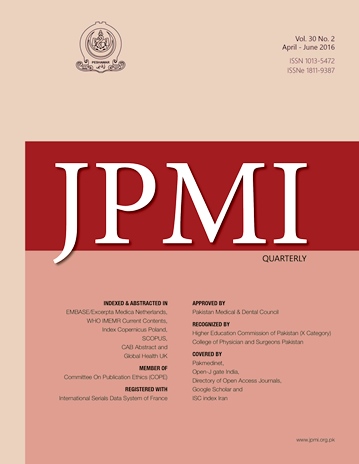PROPHYLACTIC RECTAL NSAIDS IN THE PREVENTION OF POST-ERCP PANCREATITIS
Main Article Content
Abstract
Objective: To evaluate the effectiveness of rectal non-steroidal anti-inflammatory drugs (NSAIDs) using diclofenac in preventing pancreatitis following ERCP. Methodology: It was a randomized, double blinded, placebo controlled study carried out at Surgical Unit-I, Holy Family Hospital, Rawalpindi from May 2013 to April 2014. A total of 108 patients were included and randomly assigned in each of study and placebo groups. Group I patients received 100 mg of diclofenac per rectally while group II patients received a glycerine suppository per rectally (placebo) before the start of ERCP. Post ERCP pancreatitis (PEP) was diagnosed by clinical evaluation and raised serum amylase levels after four hours of the procedure in both groups (study vs control). Results: Out of 108 patients 32 were males and 76 were females. Mean age was 46.09 ±12.31 in group I, while it was 42.93 ±14.69 in Group II. Mean serum amylase level, 4 hours after ERCP, was 184.70 ±36.34 in the diclofenac group, while it was 388.20 ±57.27 IU/L in the control group. Thirty one patients were diagnosed with Post ERCP pancreatitis, out of which nine patients belonged to the study group and twenty two were of the control group (P = 0.000). Conclusion: Per-rectal administration of diclofenac suppository prior to ERCP results in significant reduction in the frequency of ERCP induced pancreatitis.
Article Details
How to Cite
1.
Shafique MS, Khan JS, Fayyaz MU, Zafar S, Nasrullah M, Ahmad R. PROPHYLACTIC RECTAL NSAIDS IN THE PREVENTION OF POST-ERCP PANCREATITIS. J Postgrad Med Inst [Internet]. 2016 Apr. 28 [cited 2025 Dec. 5];30(2). Available from: https://jpmi.org.pk/index.php/jpmi/article/view/1883
Issue
Section
Original Article
Work published in JPMI is licensed under a
Creative Commons Attribution-NonCommercial 2.0 Generic License.
Authors are permitted and encouraged to post their work online (e.g., in institutional repositories or on their website) prior to and during the submission process, as it can lead to productive exchanges, as well as earlier and greater citation of published work.


